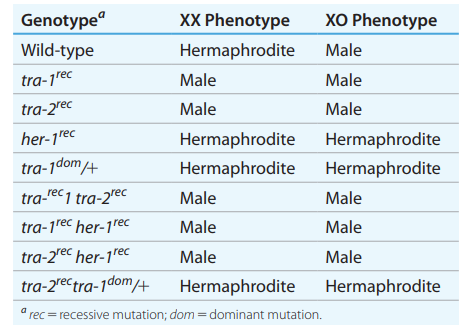
In C. elegans there are two sexes: hermaphrodite and male. Sex is determined by the ratio of X chromosomes to haploid sets of autosomes (X

Want to see the full answer?
Check out a sample textbook solution
Chapter 20 Solutions
Genetic Analysis: An Integrated Approach (2nd Edition)
- One reason that worker bees forgo their own reproduction to help their sister (the queen) reproduce is that female bees are more closely related to their sisters than they are to their own offspring. This quirk of genetics results from the fact that bees have haplodiploid sex determination, in which females are diploid, with a mother and a father, but males are haploid, developing from unfertilized eggs. Because males are haploid, they produce sperm by mitosis. Explainwhy haplodiploid sex determination causes females to be more closely related to their sisters than to their offspring.arrow_forwardFor each of the following, identify what characteristics of a species male and female karyotype would indicate that mechanism of sex-determination. Genic XY sex chromosomes ZW sex chromosomes Haplo-diploid genomes XO sex chromosomes Environmental [Choose ] [C [C [C [C [C ✓ [Choose ] More than one answer is correct Females have one more chromosome compared to males Females have twice as many chromosomes compared to males Females show a pair of differentiated sex chromosomes Males show a pair of differentiated sex chromosomes No visible differencearrow_forwardnote: the cirled answer might be right or wrongarrow_forward
- A sexually reproducing animal has two genes that assort independently, one for head shape (H) and one for tail length (T). Its genotype is HhTt. Which of the following genotypes is possible in a gamete from this organism?arrow_forwardWhich of the following is true about sex determination in mammals? Choose all possible answers. a.) The conversion of the genital ridge into the bipotential gonad requires the Sf1, Wt1, and Lhx9 transcription factors. b.) Even if one of the transcription factors mentioned in choice a (Sf1, Wt1, and Lhx9) will lose its function, the normal development of either male or female gonads will still push through. c.) Sry protein binds to the enhancer of the Sox9 gene and elevates expression of this key gene in the ovary-determining pathway. d.) β-catenin functions to initiate the ovarian pathway of development by activating the genes involved in granulosa cell differentiation. e.) Sf1 protein prevents the production of Sox9.arrow_forwardFor each of the following, identify what characteristics of a species male and female karyotype would indicate that mechanism of sex-determination. In each case, list a characteristic that would be specific to only that sex-determination system if possible. If no such characteristic is possible, specify which other sex-determination system would show the same karyotype characteristic. (A) Genic (B) XY sex chromosomes (C) ZW sex chromosomes (D) Haplo-diploid genomes (E) XO sex chromosomes (F) Environmentalarrow_forward
- In ZZ-ZW sex determining systems which of the following is true? Insects such as bees, wasps, and ants use the ZZ-ZW sex determining system. The female is homogametic, while the male is heterogametic. After meiosis in the Female, half the eggs will have the Z chromosome. O The males develop from unfertilized eggs while the females develop from fertilized eggs. The SRY gene is found on the Z chromosome.arrow_forwardChromosomal nondisjunction of the X chromosome in female gametes of humans means that live offspring can include ________. A) females with XX or XXX, and males with XY or XXY B) females with XX, and males with XY C) females with XX, and males with XY or XO D) females with XX or XXX, and males with XY or XO E) females with XX or XO, and males with XY or OYarrow_forwardX-value 0.95 0.84 2.72 7.83 Y-value 0.86 0.84 0.8 0.73arrow_forward
- Butterflies have an X-Y sex-determination system that is different from that of flies or humans. Female butterflies may be either XY or X0, while butterflies with two or more X chromosomes are males. This photograph shows a tiger swallowtail gynandromorph, which is half male (left side) and half female (right side). Given that the first division of the zygote divides the embryo into the future right and left halves of the butterfly, propose a hypothesis that explains how nondisjunction during the first mitosis might have produced this unusual-looking butterfly. Question is also in the picture.arrow_forwardA sexually reproducing animal has two unlinked genes, one for head shape (H) and one for tail length (T). Its genotype is HhTt. Which of the following genotypes is possible in a gamete from this organism? HhTt T HT Hharrow_forwardWhat, if anything, does this experiment indicate about the validity of the pangenesis and the germ-plasm theoriesarrow_forward
 Biology: The Dynamic Science (MindTap Course List)BiologyISBN:9781305389892Author:Peter J. Russell, Paul E. Hertz, Beverly McMillanPublisher:Cengage Learning
Biology: The Dynamic Science (MindTap Course List)BiologyISBN:9781305389892Author:Peter J. Russell, Paul E. Hertz, Beverly McMillanPublisher:Cengage Learning Biology Today and Tomorrow without Physiology (Mi...BiologyISBN:9781305117396Author:Cecie Starr, Christine Evers, Lisa StarrPublisher:Cengage Learning
Biology Today and Tomorrow without Physiology (Mi...BiologyISBN:9781305117396Author:Cecie Starr, Christine Evers, Lisa StarrPublisher:Cengage Learning


